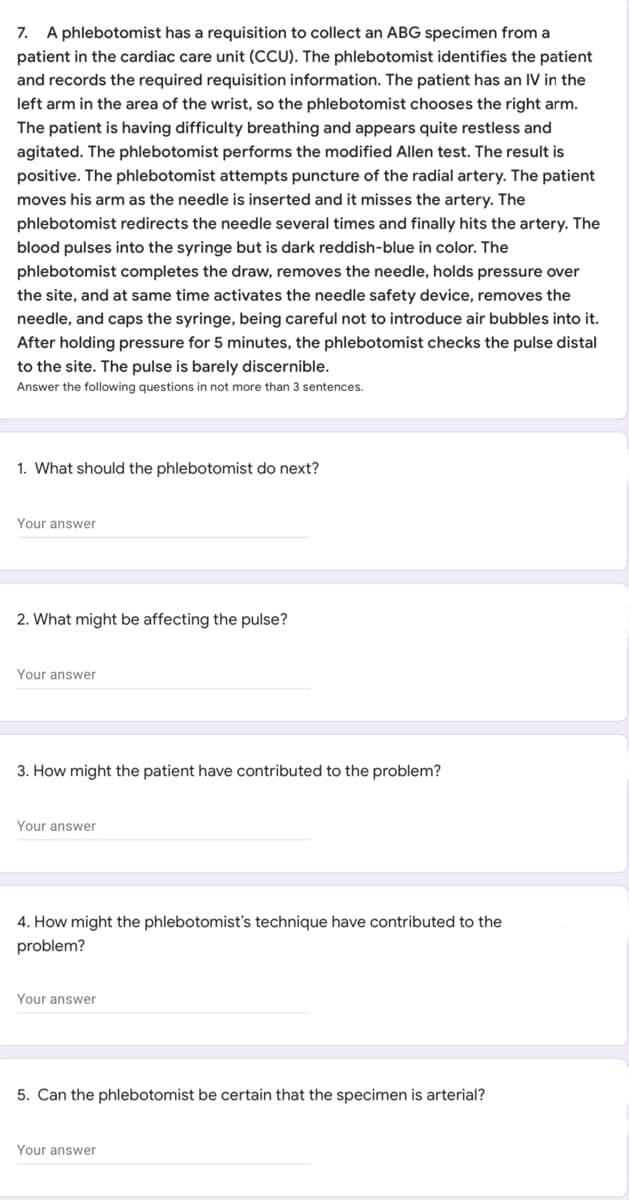7. A phlebotomist has a requisition to collect an ABG specimen from a patient in the cardiac care unit (CCU). The phlebotomist identifies the patient and records the required requisition information. The patient has an IV in the left arm in the area of the wrist, so the phlebotomist chooses the right arm. The patient is having difficulty breathing and appears quite restless and agitated. The phlebotomist performs the modified Allen test. The result is positive. The phlebotomist attempts puncture of the radial artery. The patient moves his arm as the needle is inserted and it misses the artery. The phlebotomist redirects the needle several times and finally hits the artery. The blood pulses into the syringe but is dark reddish-blue in color. The phlebotomist completes the draw, removes the needle, holds pressure over the site, and at same time activates the needle safety device, removes the needle, and caps the syringe, being careful not to introduce air bubbles into it. After holding pressure for 5 minutes, the phlebotomist checks the pulse distal to the site. The pulse is barely discernible. Answer the following questions in not more than sentences. 1. What should the phlebotomist do next? Your answer 2. What might be affecting the pulse? Your answer 3. How might the patient have contributed to the problem? Your answer 4. How might the phlebotomist's technique have contributed to the problem? Your answer 5. Can the phlebotomist be certain that the specimen is arterial? Your answer
7. A phlebotomist has a requisition to collect an ABG specimen from a patient in the cardiac care unit (CCU). The phlebotomist identifies the patient and records the required requisition information. The patient has an IV in the left arm in the area of the wrist, so the phlebotomist chooses the right arm. The patient is having difficulty breathing and appears quite restless and agitated. The phlebotomist performs the modified Allen test. The result is positive. The phlebotomist attempts puncture of the radial artery. The patient moves his arm as the needle is inserted and it misses the artery. The phlebotomist redirects the needle several times and finally hits the artery. The blood pulses into the syringe but is dark reddish-blue in color. The phlebotomist completes the draw, removes the needle, holds pressure over the site, and at same time activates the needle safety device, removes the needle, and caps the syringe, being careful not to introduce air bubbles into it. After holding pressure for 5 minutes, the phlebotomist checks the pulse distal to the site. The pulse is barely discernible. Answer the following questions in not more than sentences. 1. What should the phlebotomist do next? Your answer 2. What might be affecting the pulse? Your answer 3. How might the patient have contributed to the problem? Your answer 4. How might the phlebotomist's technique have contributed to the problem? Your answer 5. Can the phlebotomist be certain that the specimen is arterial? Your answer
Chapter22: Controlling Health Care Costs
Section: Chapter Questions
Problem 2AE
Related questions
Question
100%
Please answer numbers 4 and 5.

Transcribed Image Text:7. A phlebotomist has a requisition to collect an ABG specimen from a
patient in the cardiac care unit (CCU). The phlebotomist identifies the patient
and records the required requisition information. The patient has an IV in the
left arm in the area of the wrist, so the phlebotomist chooses the right arm.
The patient is having difficulty breathing and appears quite restless and
agitated. The phlebotomist performs the modified Allen test. The result is
positive. The phlebotomist attempts puncture of the radial artery. The patient
moves his arm as the needle is inserted and it misses the artery. The
phlebotomist redirects the needle several times and finally hits the artery. The
blood pulses into the syringe but is dark reddish-blue in color. The
phlebotomist completes the draw, removes the needle, holds pressure over
the site, and at same time activates the needle safety device, removes the
needle, and caps the syringe, being careful not to introduce air bubbles into it.
After holding pressure for 5 minutes, the phlebotomist checks the pulse distal
to the site. The pulse is barely discernible.
Answer the following questions in not more than sentences.
1. What should the phlebotomist do next?
Your answer
2. What might be affecting the pulse?
Your answer
3. How might the patient have contributed to the problem?
Your answer
4. How might the phlebotomist's technique have contributed to the
problem?
Your answer
5. Can the phlebotomist be certain that the specimen is arterial?
Your answer
Expert Solution
This question has been solved!
Explore an expertly crafted, step-by-step solution for a thorough understanding of key concepts.
This is a popular solution!
Trending now
This is a popular solution!
Step by step
Solved in 2 steps

Recommended textbooks for you



Case Studies In Health Information Management
Biology
ISBN:
9781337676908
Author:
SCHNERING
Publisher:
Cengage



Case Studies In Health Information Management
Biology
ISBN:
9781337676908
Author:
SCHNERING
Publisher:
Cengage

Comprehensive Medical Assisting: Administrative a…
Nursing
ISBN:
9781305964792
Author:
Wilburta Q. Lindh, Carol D. Tamparo, Barbara M. Dahl, Julie Morris, Cindy Correa
Publisher:
Cengage Learning

Basic Clinical Lab Competencies for Respiratory C…
Nursing
ISBN:
9781285244662
Author:
White
Publisher:
Cengage
